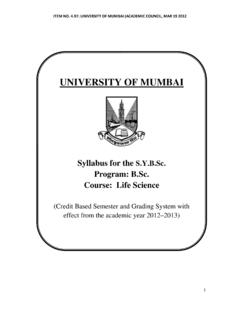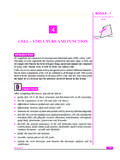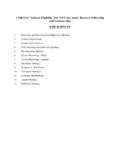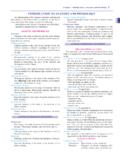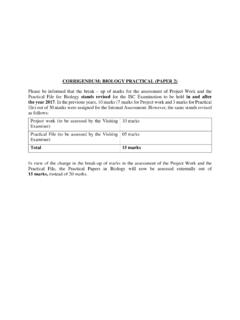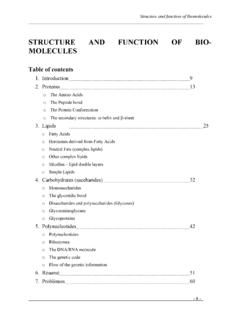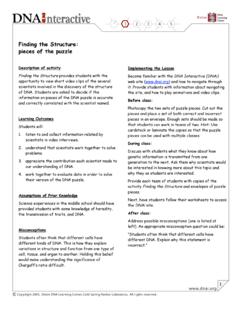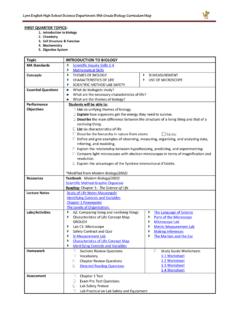Transcription of UNIVERSITY OF MUMBAI - Jai Hind College
1 ITEM NO. : UNIVERSITY OF MUMBAI (ACADEMIC COUNCIL, MAR 19 2012). UNIVERSITY OF MUMBAI . Syllabus for the Program: Course: Life Science (Credit Based Semester and Grading System with effect from the academic year 2012 2013). 1. ITEM NO. : UNIVERSITY OF MUMBAI (ACADEMIC COUNCIL, MAR 19 2012). NEW SYLLABUS OF IN LIFE SCIENCES. (SEMESTER BASED CREDIT AND GRADING SYSTEM). TO BE IMPLEMENTED FROM THE ACADEMIC YEAR 2012-2013. Semester I. USLSC 101. Life sciences at the molecular and cellular levels (Total Lectures: 45). (The number of periods for each topic is given in brackets). PREAMBLE: The first step to understand life forms is to understand the molecular logic of a living cell. This paper develops the concept of biochemical basis of plant and animal life and the underlying uniformity that forms the basis of all organisms at the cellular level. Unit I Features of living cells : 15 lectures 1. Molecular Logic of a living cell: (1). An introduction to Life Sciences stressing the significance of the topics that follow.
2 2. Physiological Role of water: (3). Structure of water molecule, ionic interactions, ionic product of water, concept of pH, buffer and buffering system in cells, role of inorganic ions. 3. Proteins: (6). Amino acids: Classification, chemical reactions (Ninhydrin, Edmans, Sangers) of amino acids, peptides, protein structure, globular proteins (Hemoglobin) & Fibrous proteins (keratin), structure of proteins, types of bonds contributing to protein structure. 4. Carbohydrates: (5). Structure, chemical and physical properties of monosaccharides, disaccharides (maltose, sucrose, lactose), polysaccharides (starch, glycogen and cellulose). Unit II Concept of prokaryotic and eukaryotic cells 15 lectures 1. Study of prokaryotic and Eukaryotic cell: (3). a. Microscopy as a tool for Cell Biology studies: Principles of light and electron microscopy Prokaryotic cell structure. E. coli b. Eukaryotic cell structure. Yeast (Unicellular), Plant and Animal cell (Multicellular). c. Evolutionary origin of organelles and endosymbiont hypothesis.
3 2. Virus: (3). Virion structure, Life cycle of bacteriophage (Lytic and Lysogenic), Plant and Animal 2. ITEM NO. : UNIVERSITY OF MUMBAI (ACADEMIC COUNCIL, MAR 19 2012). virus (One example each). 3. Microbial growth: (3). Influencing factors, culture media (enriched and minimal), isolation, preservation, Life cycle and Growth Curve of E. coli. 4. Cell cycle(G0, G1, S, G2, M phases) (3). 5. Structure of cell wall: (3). a. Bacterial cell wall: Gram positive and Gram negative. b. Plant cell wall: Primary and secondary Unit III: Nucleus, Cytoskeleton and Cell division 15 lectures 1. Nucleus : (4). Structure of an interphase nucleus : nuclear membrane, nucleolus, nucleosome model, euchromatin and heterochromatin, lampbrush and polytene chromosomes 2. Cytoskeletal elements: (5). a. Microfilaments: Structure and function in striated muscle fibers. Role in cytoplasmic streaming in plants. b. Mictolubules: Structure as in cilia or in flagella, mechanism in movement. Function in mitotic spindle.
4 C. Intermediate filaments: Structure and function. 3. Mitosis and Meiosis & their significance (6). SEMESTER I. USLSC 102. LIFE SCIENCES AT SYSTEM, ORGANISM AND COMMUNITY LEVEL. PREAMBLE: Organisms adapt to environment they live in which reflects as biodiversity in animals and plants. These adaptations are often physiological and have a genetic basis. This paper is an introduction to the underlying biological mechanisms at organismic level. Unit I 15 lectures Multicellularity and specialized functions 1. Classification 5 kingdoms (details in Practicals) (2). -- Concept of multicellularity and division of labour (volvox and sponges as examples). -- Specialization of animal cells and plant cells with respect to function 2. Organization into tissues (2). 3. ITEM NO. : UNIVERSITY OF MUMBAI (ACADEMIC COUNCIL, MAR 19 2012). - Introduction to plant and animal tissues (details in practicals). 3. Tissues to organs and systems (4). (Just list the various systems with main organs and functions).
5 Group systems as i) For maintenance of organism (Nutrition/Digestion, Transport and circulation, respiration, osmoregulation and excretion and support and locomotion). ii) Control and Coordination (Endocrine, Nervous, Immune, Reproduction). 4. NUTRITION Autotrophic and Heterotrophic (7). 1. Autotrophic nutrition Importance of photosynthesis in plants and in autotrophic prokaryotes (photosynthetic and chemosynthetic eg. nitrifying bacteria), cyanobacteria. Macro and micro nutrients for plants. Nutritional adaptations involve relationships with other organisms eg. insectivorous plants and symbiotic nitrogen fixation. 2. Heterotrophic nutrition ex. holozoic, saprophytic (fungi) and parasitic (tapeworm). Holozoic nutrition i) fluid feeders (ex mosquito or housefly) ii) microphagous (ex. amoeba or paramecium) iii) macrophagous (mammals). Digestive systems of mammals (each organ of mammalian digestive system has specialized food-processing function). Evolutionary adaptation associated with diet eg.
6 Dental, stomach and intestine (ruminant). Unit II 15 lectures TRANSPORT AND CIRCULATION (9). 1. Transport in plants Transport of water and inorganic solutes transpiration, stomatal function and regulation, role of proton pumps and factors affecting ascent of xylem sap. Transport of organic solutes mechanism and its regulation 2. Circulation in animals i) Animals without a circulatory system eg. hydra and jellyfish ii). Open and closed circulatory system eg. insects vs worms 3. Vertebrate circulatory system heart, single and double circulation. Specific adaptations mammals at high altitudes and diving mammals Cardiovascular system in health and disease exercise, hypertension and atherosclerosis SUPPORT AND LOCOMOTION (6). Support in plants herbaceous and woody plants Types of skeletons hydrostatic (nematodes), exoskeleton (arthropods/molluscs) and endoskeletons (vertebrates). 4. ITEM NO. : UNIVERSITY OF MUMBAI (ACADEMIC COUNCIL, MAR 19 2012). Role of muscle in locomotion Locomotion in earthworm Locomotion in humans axial and appendicular skeleton and joints Unit III 15 lectures RESPIRATION AND GASEOUS EXCHANGE (7).
7 Aerobic and anaerobic respiration Gas exchange in small animals (across surface) and cutaneous respiration in frogs. Gas exchange in plants also pneumatophores Gaseous exchange in invertebrates trachea in insects, book lungs in scorpion Gaseous exchange in vertebrates gills and lungs Respiratory pigments O2 and CO2 balance EXCRETION AND OSMOREGULATION (8). In plants water and salt regulation under normal and stressed conditions In animals Phylogenetic review of organs and processes - contractile vacuole, flame cells, nephridium, malpighian tubules, kidney and skin in man Concept of osmoregulation and processes associated with osmoregulation (ultrafiltration, selective re-absorption, secretion, acid-base regulation). Nitrogenous excretory products (ammonotelism, ureotelism and uricotelism). Case studies : mammals in arid regions (camel); salt glands in birds (LIFE SCIENCES). SEMESTER I. PRACTICAL. USLSCP1. (Based on paper I). 1. a. An introduction to Laboratory discipline and GLP (Good Laboratory practices).
8 B. Survey of the organization of laboratory instruments, chemicals and glasswares [incorporated into every practical ]. 2. Introduction to Elementary microbial techniques : (3). 5. ITEM NO. : UNIVERSITY OF MUMBAI (ACADEMIC COUNCIL, MAR 19 2012). a. Sterilization & Disinfection b. Microbial Staining technique and Microscopy: Comparative study of samples from 5 different sources to check gram + and gram . bacteria - Butter milk, tap water, sewage water food item soil, rotten effect of heat using a. Monochrome b. Gram Staining c. Cell wall staining 3. Colorimetry (3). a. Preparation of solutions of a given chemical compound - Molar and percentage solutions - Concept and calculation only. b. Preparation of dilutions of required concentration from a stock solution of a colored compound c. Estimation of Lambda max of a coloured solution d. Verification of Beer Lambert's law for a coloured solution 4. Molecular biology and Biochemistry: (2). a. Detection of DNA from Onion or any other convenient, cost -effective system.
9 B. Detection of Carbohydrates ( atta), Lipids ( nut oil). and proteins (eg. Any edible protein). 5. Instrumentation and techniques: (2). a. Calibration of the pH Meter with standard buffer pH4 and as per GLP. b. Checking of pH for common foodstuff Milk/cola drink/Lime juice or any other relevant sample SEMESTER I. PRACTICAL. USLSCP1. (Based on paper II). 1. Study of Tissues : (2). a. Tissues Temporary mounting of of Sunflower and Maize stem and root i. Comparison between Dicot stem and Monocot stem ii. Comparison between Dicot root and Monocot root b. Animal Tissues ( Permanent slides). i. Epithellial Squamous, Cuboidal, epithelial ii. Connective Aeriolar, Adipose, cartilage, bone 6. ITEM NO. : UNIVERSITY OF MUMBAI (ACADEMIC COUNCIL, MAR 19 2012). iii. Muscular Striated, non- striated, Cardiac iv. Nervous Medulated, non-medulated neurons 2. Hematology (2). a. Total RBC count using Hemocytometer b. Observe different WBCs using Giemsa/ Lieishman stain 3. Mounting of Dicot / Monocot stomata (structure and function) (1).
10 4. Diversity of Life ( present specimens/pictures/models) (3). Five Kingdom classification Classification of Monera, Protoctista, Fungi Classification of Plants : Using common plants prescribed in the chart provided below) . 5. Study of Mouth parts in insect (3). Comparative assessment of mouth parts across genus (eg. Mosquito). Or Comparative assessment of mouth parts according to function as given below a. Biting and Chewing type- eg Cockroach b. Piercing and sucking type- eg Mosquito c. Sponging type- eg Housefly 6. Mounting of nephridium of earthworm and permanent slide of kidney (1). Semester II. USLSC 201. Life sciences at the molecular and cellular levels (Total Lectures: 45). (The number of periods for each topic is given in brackets). Unit I Features of living cells(cont'd)and biochemical separation techniques 15 lectures 1. Lipids: (4). Classification of lipids (simple, derived and complex with one example each). 2. Nucleic acids: (6). Structure of nucleosides and nucleotides, structure of nucleic acids (A,B,Z forms); the structure of DNA lends itself to its function as hereditary molecule.
